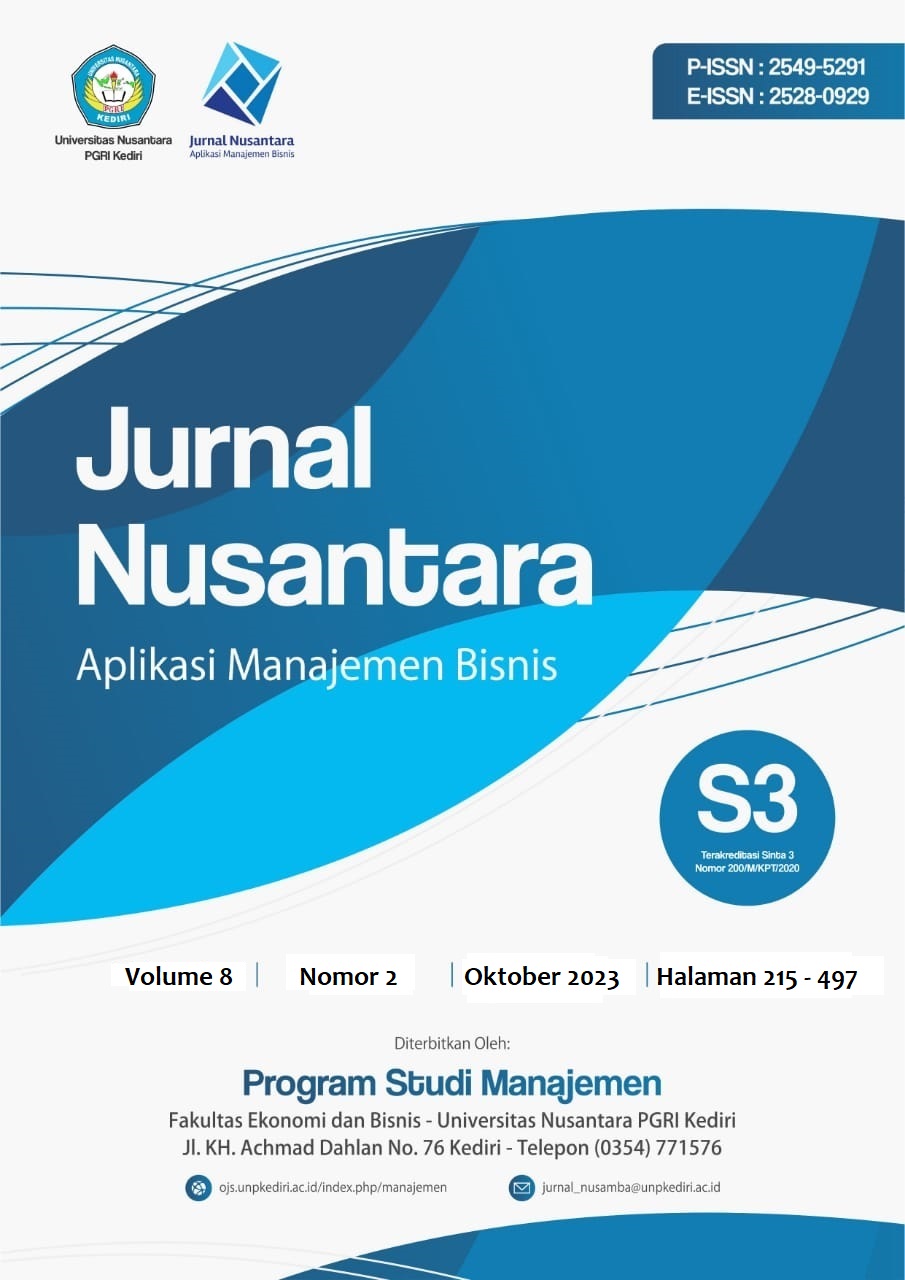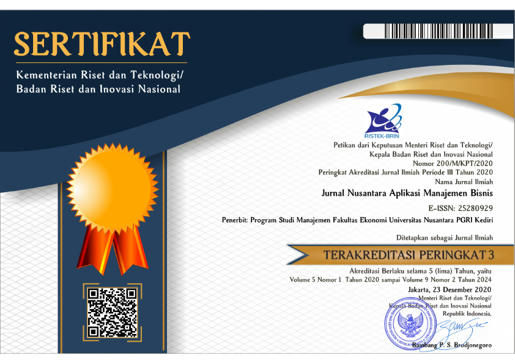Analisis Strategi Customer Bonding Untuk Membangun Loyalitas Pelanggan Pada Labella Hijab Store Lamongan
DOI:
https://doi.org/10.29407/nusamba.v8i2.18518Keywords:
Customer Bonding, Digital Marketing, Customer LoyaltyAbstract
Research aim : This study aims to describe the implementation of customer bonding strategies through digital marketing in building customer loyalty at Labella Hijab Store Sendangagung Paciran Lamongan.
Design/Methode/Approach : This study used a qualitative research method with a descriptive qualitative approach. Data collection techniques through observation, interviews and documentation.
Research Finding : The results showed that Labella Hijab Store used five levels of customer bonding: awareness bonding, identity bonding, relationship bonding, community bonding and advocacy bonding. Labella Hijab's type of customer loyalty is at the highest level, namely: liking the brand and committed. The results of this study also show the importance of Labella Hijab Store in maintaining and improving customer bonding strategies, especially through optimizing advocacy bonding by stimulating the birth of indirect marketers on an ongoing basis, in an effort to bind and strengthen customer trust so that loyalty increases.
Theoretical contribution/Originality : This research provides evidence that implementing a customer bonding strategy accompanied by digital marketing via the internet with various platforms such as web, social media and e-commerce is very effective in maintaining hijab sales.in binding and fostering a sense of customer trust.
Practitionel/Policy implication : The strategy of customer bonds and digital marketing has a role in increasing sales, binding and growing trust in consumers, so management must use the two combined strategies in order to be able to buildmassive customer loyalty.
Research limitation : This research only focuses on customer bonding factors and digital marketing through social media only.
Downloads
References
[2] Simanmora, B. 2001. Remarketing for Bussines Recovery. Gramedia Pustaka Jakarta.
[3] Kleindl B. dan J. L. Burrow. 2009. E-Commerce Marketing. South Western. United States of America.
[4] Nisa’, C. 2021. Strategi Mempertahankan Loyalitas Pelanggan pada Gribel Mentari Ahe Unit Klitik. Skripsi. Fakultas Ekonomi dan Bisnis. Institut Agama Islam Negeri Ponorogo.
[5] Majid, A. 2020. Implementasi Strategi Customer Bonding di PT. Mina Wisata Islami Tour dan Travel Surabaya. Skripsi. Fakultas Dakwah dan Komunikasi. Universitas Negeri Sunan Ampel Surabaya.
[6] Oktaviani, F. dan D. Rustandi. 2018. Implementasi Digital Marketing dalam membangun Brand Awareness. Jurnal Ilmiah Ilmu Hubungan Masyarakat 3 (1): 01.
[7] Afriasih, M. C. U. 2018. Analisis Penerapan Strategi Customer Bonding terhadap Loyalitas Pelanggan pada Member The Face Shop PVJ Bandung. Jurnal Indonesia Membangun 13 (1).
[8] Abrarms, R. 2010. Bussines Plan in A Day. 3rd Edition. Planning Shop. Reawood. Terjemahan Y. A. Vivin. 2008. Cara Jitu Membuat Bisnis. Kanisius. Yogyakarta.
[9] Kertajaya H. 2017. On Selling. Mizan. Bandung.
[10] Palmer, R. 2007. Managing Marketing. Elsivier. Oxford.
[11] Muljono, R. K. 2018. Digital Marketing Concept. Gramedia. Jakarta.
[12] Chaffey D. dan E. F. Chadwick. 2016. Digital Marketing Strategy, Implementation and Practice. 6th Ed. Pearson. United Kingdom.
[13] Sanjaya R. dan J. Tarigan. 2009. Creative Digital Maerketing: Teknologi Berbiaya Murah, Inovatif dan Berdaya Hasil Gemilang. Elex Media Komputindo. Jakarta.
[14] Adam, M. 2018. Manajemen Pemasaran Jasa. Edisi 2. Alfabeta. Bandung.
[15] Kurriwati, N. 2015. Pengaruh Kualitas Produk terhadap Kepuasan dan Dampaknya terhadap Loyalitas Pelanggan. Jurnal Eco-Preneur 1 (1):50.
[16] Supranto, J. 2006. Pengukuran Tingkat Kepuasan Pelanggan untuk Meningkatkan Pangsa Pasari. Edisi 2. Rineka Cipta. Jakarta.
[17] Hasan, I. 2014. Pokok-Pokok Materi Statistik I, Statistik Deskriptif. Edisi 2. Bumi Kasara. Jakarta.
[18] Arikunto, S. 2011. Prosedur Penelitian: Studi Pendekatan Praktik. Rineka Cipta. Jakarta.
[19] Moelong, L. J. 2007. Metode Penelitian Kualitatif. Edisi Revisi. Remaja Rosda Karya. Bandung.
[20] Iswati, S., dan A. Muslich. 2017. Metodelogi Penelitian Kualitatif. Airlangga University Press. Surabaya.
[21] Umar, H. 2014. Riset Pemasaran dan Perilaku Konsumen. Gramedia Pustaka Utama. Jakarta.
[22] Kotler P. dan G. Armstrong. 2008. Principles of Marketing. 9th ed. Prentice Hall. New Jersey. Terjemahan Sabran B. 2008. Prinsip-Prinsip Pemasaran. Edisi 12. Erlangga. Jakarta.
Downloads
Published
Issue
Section
License
Authors who publish with this journal agree to the following terms:
- Copyright on any article is retained by the author(s).
- The author grants the journal, the right of first publication with the work simultaneously licensed under a Creative Commons Attribution License that allows others to share the work with an acknowledgment of the work’s authorship and initial publication in this journal.
- Authors are able to enter into separate, additional contractual arrangements for the non-exclusive distribution of the journal’s published version of the work (e.g., post it to an institutional repository or publish it in a book), with an acknowledgment of its initial publication in this journal.
- Authors are permitted and encouraged to post their work online (e.g., in institutional repositories or on their website) prior to and during the submission process, as it can lead to productive exchanges, as well as earlier and greater citation of published work.
- The article and any associated published material is distributed under the Creative Commons Attribution-ShareAlike 4.0 International License












